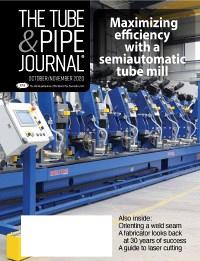Managing Director
- FMA
- The Fabricator
- FABTECH
- Canadian Metalworking
Categories
- Additive Manufacturing
- Aluminum Welding
- Arc Welding
- Assembly and Joining
- Automation and Robotics
- Bending and Forming
- Consumables
- Cutting and Weld Prep
- Electric Vehicles
- En Español
- Finishing
- Hydroforming
- Laser Cutting
- Laser Welding
- Machining
- Manufacturing Software
- Materials Handling
- Metals/Materials
- Oxyfuel Cutting
- Plasma Cutting
- Power Tools
- Punching and Other Holemaking
- Roll Forming
- Safety
- Sawing
- Shearing
- Shop Management
- Testing and Measuring
- Tube and Pipe Fabrication
- Tube and Pipe Production
- Waterjet Cutting
Industry Directory
Webcasts
Podcasts
FAB 40
Advertise
Subscribe
Account Login
Search
Helping manufacturers maintain the momentum of innovation
Trends in innovations during the COVID-19 crisis should continue across all industry sectors
- By Neil Shah
- November 18, 2020
- Article
- Shop Management
If one thing is certain when it comes to the coronavirus pandemic, it’s that uncertainties are a given. The U.S. manufacturing industry is no exception to this rule as firms across the country pivoted quickly to adjust to the demands wrought by the pandemic. What is most exciting, however, is that many U.S. manufacturing companies have seen the pandemic not just as a hurdle, but an opportunity to innovate. This is the mindset that should be harnessed even after the pandemic has run its course.
Looking at the numbers, despite the fact that the industry’s overall productivity contracted in the initial months of the pandemic—the PMI fell to 48.5 in March from 50.7 in February— U.S. manufacturing has shown both resilience and the ability to adapt to shifting consumer needs. For example, the Department of Energy’s Manufacturing Demonstration Facility and Carbon Fiber Technology Facility at Oak Ridge National Laboratory used their “materials science, fiber production, and additive manufacturing expertise and capabilities to produce tooling such as custom molds for injection molding to provide U.S. industry with the necessary resources to mass produce health care supplies in record time,” according to the ORNL website.
A Culture Shock Works
Other firms have wholly upended worksite culture to implement social distancing measures, sometimes by removing “floating” workers and dedicating employees to a single production line. They also are leveraging technology like Zoom to conduct shift handover meetings while minimizing the number of employees on the shop floor.
A survey conducted by MC Machinery Systems, for example, found that 60% of manufacturing employees think the pandemic revealed opportunities for collaborative manufacturing—which involves companies forming partnerships to bundle ideas and improve processes—and automation technologies. The type of collaborative manufacturing established during the pandemic may or may not survive after the coronavirus is finally gone, but again, it would be best if the willingness to embrace new ideas, processes, and technologies would remain.
Manufacturing companies in the U.S. should keep two things in mind when the pandemic begins to abate. First, it’s crucial to embrace a culture of innovation by prioritizing Industry 4.0 technology; second, it’s even more important to leverage available tools and incentives to ensure a continuous work flow that embraces this innovative mindset.
Taking New Tech to the Next Level
Long before the pandemic upended nearly everything, Industry 4.0 technology was making an impact on U.S. manufacturing firms. For example, 39% of industry leaders had implemented a “nerve-center” approach to increase supply chain transparency.
Through connectivity, computer power, lighting-fast data analytics, the latest engineering, and the partnership of humans and machinery, Industry 4.0 has helped to bolster the sector in this time of need. According to McKinsey, its recent survey of manufacturing professionals “found that 93% plan to focus on resilience of their supply chain, and 90% plan to invest in talent for digitization.”
Any skeptics of the power of Industry 4.0 need to take a look at the impact it has had during the pandemic and consider its continued effects in the postcoronavirus environment. It’s tough to see the silver linings in the face of such a disastrous health and economic environment, but the industry will undoubtedly come out the other side stronger.
Where Things Are Headed
Despite the negative toll on the sector, 37% of manufacturing firms believe that the pandemic’s revenue impact on their customers will be mild and short-lived. Now is the time for manufacturing companies to plan for a resurgence of productivity and ensure that their operations can handle an industry upswing.
According to a June 2, 2020, article in The Wall Street Journal, many already are planning to spend “far more on data management and analytics tools in the aftermath of the coronavirus outbreak and will be using those tools for deeper insight into operations, sales, and supply chain disruptions, chief information officers and observers say.”
It’s obvious that capital is required to embrace an innovative mindset effectively through the leveraging of new technologies. Despite Congress’s best attempts to help American businesses weather the storm, there were still hiccups with available loan programs.
Tools for Capital Already Available
U.S. manufacturing firms should strongly consider government incentives that are already available, especially ones that don’t need to be paid back. The R&D Tax Credit offered under Section 41 of the U.S. Tax Code allows companies of all sizes to significantly reduce their tax liability if they are working to improve any product or process.
Manufacturing companies make up one of the largest groups to claim the credit, and Congress has recently touted its effectiveness, even suggesting doubling the credit to leverage it as an economic recovery tool. U.S. manufacturing firms have been able to use the credit to invest in company infrastructure, new employees, and new technologies.
Doubling the credit would be a boon to industry, but manufacturing companies shouldn’t wait for that to happen; they should proceed now to claim any tax credit they can get to reinvest in the necessary innovation efforts to prepare for life after the coronavirus.
U.S. manufacturing firms are a core facet of our country’s economy. The industry has proven its resilience during the pandemic and will have a great opportunity use the lessons learned to thrive once we get back to “normal.”
About the Author

About the Publication
subscribe now

The Tube and Pipe Journal became the first magazine dedicated to serving the metal tube and pipe industry in 1990. Today, it remains the only North American publication devoted to this industry, and it has become the most trusted source of information for tube and pipe professionals.
start your free subscription- Stay connected from anywhere

Easily access valuable industry resources now with full access to the digital edition of The Fabricator.

Easily access valuable industry resources now with full access to the digital edition of The Welder.

Easily access valuable industry resources now with full access to the digital edition of The Tube and Pipe Journal.
- Podcasting
- Podcast:
- The Fabricator Podcast
- Published:
- 04/16/2024
- Running Time:
- 63:29
In this episode of The Fabricator Podcast, Caleb Chamberlain, co-founder and CEO of OSH Cut, discusses his company’s...
- Trending Articles
Team Industries names director of advanced technology and manufacturing

Orbital tube welding webinar to be held April 23

Chain hoist offers 60-ft. remote control range

Push-feeding saw station cuts nonferrous metals

Corrosion-inhibiting coating can be peeled off after use

- Industry Events
16th Annual Safety Conference
- April 30 - May 1, 2024
- Elgin,
Pipe and Tube Conference
- May 21 - 22, 2024
- Omaha, NE
World-Class Roll Forming Workshop
- June 5 - 6, 2024
- Louisville, KY
Advanced Laser Application Workshop
- June 25 - 27, 2024
- Novi, MI



























